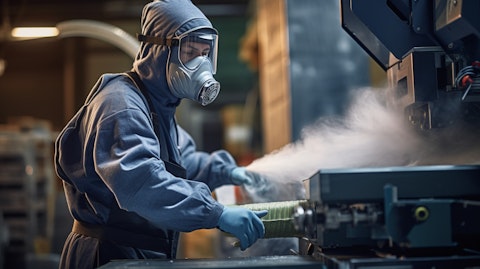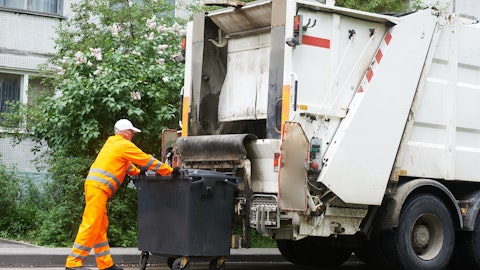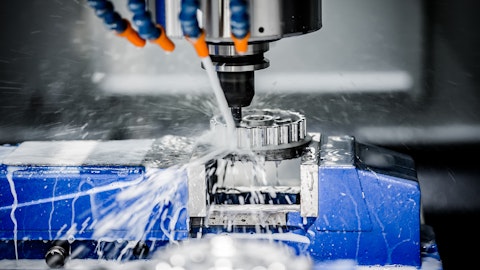Aqua Metals, Inc. (NASDAQ:AQMS) Q4 2023 Earnings Call Transcript March 27, 2024
Aqua Metals, Inc. isn’t one of the 30 most popular stocks among hedge funds at the end of the third quarter (see the details here).
Operator: Good afternoon, and welcome to the Aqua Metals Fourth Quarter Financial Results Conference Call. At this time, all participants are in a listen-only mode. A question and answer session will follow the formal presentation. [Operator Instructions] Please note this conference is being recorded. I’ll now turn the call over to our host Bob Meyers with FNK IR. Bob, please go ahead.
Bob Meyers: Thank you, operator, and thank you, everybody, for joining. Earlier today, Aqua Metals issued a press release providing an operational update and discussing financial results for the fourth quarter and full year ended December 31, 2023. This release is available in the Investor Relations section on the company’s website at aquametals.com. Hosting the call today are Steve Cotton, President and Chief Executive Officer; and Judd Merrill, Chief Financial Officer. Before we begin, I would like to remind participants that during the call, management will be making forward-looking statements. Please refer to the company’s report on Form 10-K filed today, March 27th, for a summary of the forward-looking statements and the risks, uncertainties, and other factors that could cause actual results to differ materially from those forward-looking statements.
Aqua Metals cautions investors not to place undue reliance on any forward-looking statements. The company does not undertake and specifically disclaims any obligation to update or revise such statements to reflect new circumstances or unanticipated events as they occur except as required by law. As a reminder, after the formal remarks, we will be taking questions. Questions will be accepted over the phone from analysts and all other investors can submit a question using the online webcast portal provided in today’s and earlier press releases. We will take as many questions as we can in our available time slot. To start the call, we will show a brief video that highlights our progress. For those that have dialed in, you will be able to hear the narration and replays will be available on the website.
Steve will lead the call from there. [Video Presentation]
Steve Cotton: To initiating commercialization and we enter 2024 advancing our commercial activities. First, our pilot plant now has over a full year of operations and learnings and is currently operating 24 hours a day and five days a week. The pilot has been producing nickel, cobalt, lithium hydroxide, lithium carbonate, and other valuable materials that we’ve been using to validate our capabilities and for providing representative materials, shipments, to an expanding list of existing and potential customers and partners. Unlike other moonshot approaches with cost overruns and delays, our commitment to pilot has served to de-risk our process, capitalization and projected operating costs for our commercial-sized Sierra-ARC facility.
The Sierra ARC campus is located right here in Tahoe-Reno Industrial Center. And Phase 1 of the arc scales our production from the pilot to 3,000 metric tons of black mass processing, which is an engineering best practice, 30 times increase over our pilot production. Importantly, development of the Sierra ARC remains on time and under budget. Judd will speak more on the budgeting side, but our ability to upfit the existing building, design, build, commission, equip, and calibrate a state-of-the-art commercial scale facility in a short timeframe with prudent spending is a testament to the hard work and accuracy with which we planned the growth strategy of the company. We continue to add key personnel to manage this facility and to expand our industry presence.
Simultaneously, we have secured our input feedstock supply of black mass. We expect Phase 1 of the Sierra ARC at its full nameplate capacity to generate approximately 30,000 average EV battery packs worth of critical battery minerals on an annual basis, or roughly $30 million of revenues at today’s metal prices. Because of the inherent economic advantages of ARC refining, including full recovery of all valuable minerals, the elimination of one-time use chemical purchases, and expensive waste streams, we believe that even at today’s lower metal prices, Phase 1 of the ARC still has favorable economics. With input feedstock established, we also now have the clear line of sight to our processing capabilities with the commissioning beginning this summer at the Sierra ARC.
For our output, we have just finalized our first key off-take agreement announced yesterday with 6K Energy. This is our first marquee off-take agreement. The supply agreement with 6K establishes a first-of-its-kind sustainable circular supply chain for minerals essential for manufacturing lithium ion batteries. Beginning in 2024, Aqua Metals will supply 6K Energy with sustainably recycled critical minerals, ramping up to provide up to 30% of the nickel and lithium carbon needed for 6K’s PlusCAM facility. This is a pivotal collaboration for both companies and the industry as we together define industry standards for low cost, low carbon, domestically produced materials. With our input, processing, and output solidified, we believe that we are moving towards significant revenues and cash flow, while revolutionizing the lithium-ion industry.
Risk mitigation is also key to our strategy. Others attempted to ramp production rapidly, requiring massive capital commitments with challenging deadlines, without systematically scaling and de-risking technology along the way. In contrast, we are moving methodically, proving our technology step by step, advancing in a phased approach to reasonable, but still meaningful production levels, and building our partner ecosystem. As we look towards the next phases of our growth, we are pursuing a variety of funding options, including non-dilutive government grants, debt, as well as traditional financing. We will, however, continue to move methodically, recognizing that this industry is still maturing. As we have said before, our strategy is also based on self-sustainability.
Flexibility is also a big part of our strategy and based on multiple revenue streams, starting with build, own, operate. But then adding licensing, joint venture, co-location, and other structures, all of which we can consider given that our IP is all developed in-house. With our unique technology and engineering design, our commercial plants are expected to require less than half of the CapEx per ton as compared to traditional hydrometallurgical players, along with an operating cost per ton advantage due to low chemical usage and a lack of waste streams like sodium sulfate, which our unique process eliminates. This efficiency and our measured approach gives us significant optionality and serves as a durable competitive advantage. In fact, we believe that the inherent environmental and economic challenges of both pyro and standard hydro effectively disqualify those processes as viable long-term solutions for the industry.

In an environment where commodity prices have shifted, this serves us well. As part of a nascent industry, we are facing some of the typical ebbs and flows in a rapidly evolving industry. Expanding our partner ecosystem is a critical component of our commercialization strategy, and we have made significant progress in this area. Beyond our just announced supply agreement with 6K Energy, we continue to make progress on our partnership as we expect to complete by April the 6K Energy funded development agreement for a specialized nitration process. As you may recall, that in October, we signed a multi-part memorandum of understanding that is the basis for our collaboration that is expected to extend for many years to come. We have taken significant steps towards our common vision of deploying the nitration process, as well as a new ARC adjacent to their PlusCAM one facility in Jackson, Tennessee.
Our partnership with Yulho continues to progress. Yulho’s first black mass production facility build out is nearly completed and operations will commence pending environmental approvals. Discussions are ongoing as we negotiate our first licensing agreement. We worked with Dragonfly Energy to supply them with what we believe is the first sustainably recycled lithium hydroxide, which they then used to produce and successfully cycle lithium ion cells with their unique dry deposition solid state technology. We believe that this is the first time sustainably recycled battery minerals have actually been tested in new batteries. As Dragonfly Energy successfully builds their production capacity, we expect them to be a buyer of our lithium products right here in Tahoe-Reno, Nevada.
Turning our attention now to overall industry dynamics, I would like to make a comment on where we see the industry going. Despite some recent negative headlines, the energy transition is alive and well, as evidenced by 30% year-over-year growth in North American EV sales. Despite some bumps in that growth curve and the deployment of over one terawatt hour of battery production capacity in the US by the decade’s end, which is literally 200 times the capacity of 2020, just a few short years ago. This represents hundreds of billions of dollars being invested in just a decade to build one of the country’s largest industries from the ground up. These new gigafactories will ramp scrap production rapidly for driving the need for sustainable recycling, to close the loop, and to help qualify domestically produced EVs for the IRA tax incentives.
As evidenced in our meetings and discussions with several gigafactory operators and auto manufacturers, we see an enormous opportunity to be a market maker and assist them in closing the loop. Stay tuned. We also strongly believe that the word recycling could be mistakenly conflated with the word sustainable. Competing technologies produce 2 times to 7 times the weight of the batteries to be recycled in greenhouse gases, and 1 times to 2 times the weight of the batteries in sodium sulfate waste streams, destined for landfills, or even oceans. In addition to environmental impacts, ARC refining allows for safe, clean jobs. Our employees do not have to wear smelting hot suits or uncomfortable chemical suits. So in summary, we believe that these partnerships, strategic investments and achievements serve as powerful validation for our technology, our strategy, and our growing position in the marketplace.
I look forward to sharing further updates with all of you soon. And for now, I’ll turn it over to our Chief Financial Officer, Judd Merrill, to discuss the results for the year ended 2023.
Judd Merrill: Thanks, Steve. Our 10-K report is finishing up some final reviews with the auditors as we made a switch from one audit firm [indiscernible], who is no longer doing public accounting company audits to four of us, a top 10 accounting firm with extensive public company experience. These final reviews will be completed shortly and we expect to file the 10-K on time before the April 1st deadline. Since the 10-K hasn’t been filed yet, I am not able to share as many financial metrics on today’s calls as I normally do. However, I am able to share some key financial information today. Let me start with the balance sheet. As of December 31, 2023, we ended the year with total cash of approximately $16.5 million. Cash on hand will support costs related to operating the pilot plant, general working capital and the ongoing outfitting and commissioning of the Phase 1 of the Sierra-ARC.
As Steve discussed, the buildout of our Phase 1 commercial facility is on schedule and under budget. It has been a priority for Aqua Metals to accurately forecast the capital needs of our phased growth plan. There were no other significant changes on our balance sheet since our last report, so I’ll move to the income statement. For 2023, we were focused on executing our operations at our pilot plant and the buildout of our commercial facility. The cost related to plant operations were approximately $6.3 million for the year. During the year, we did record modest revenue service fees from the successful completion of the NRE, or the Non-Recurring Engineering Agreement, with 6K energy. Research and development costs decreased approximately 4% compared to the year ended December 31, 2022.
General and administrative expenses increased approximately 19% for the year ended December 31, 2023 compared to the year ended December 31, 2022, which was in line with our expectations and our growth plans. For the year ended December 31, 2023, we recognized a non-cash impairment charge of approximately $4.8 million. This is related to our investment in LINICO and ACME metals. For LINICO, we wrote off $1.4 million, and this is a result of the sale of our LINICO common stock to LINICO’s parent Comstock Inc. for $600,000. In addition, we recognize a loss of $3.5 million related to the ACME construction and process as a result of the pause of the development of recycling operations. This loss is accounted for to comply with GAAP standards, but the showcase facility remains a place at ACME Taiwan and can still be operated for various prospective opportunities that Steve outlined earlier.
Net loss for the year was approximately $23.9 million or a negative $0.25 per basic and diluted share compared to a net loss of $15.4 million or a negative $0.20 per basic and diluted share for 2022. When we removed the one-time non-cash-related impairment charge, our non-GAAP net loss for the year was $19.1 million, or a negative $0.20 per basic and diluted share, which is in line with expectations for the year. Cash used in operating activities for the year ended December 31, 2023, was $3.2 million. Our cash flows from financing activities increased, related mainly from the 2023 equity raise and strategic investment from our partnership with Yulho. We believe 2024 is an important year as we finish construction and begin production at our first commercial demonstration plant, the Sierra-ARC, which we believe will begin to generate cash at a plant level in 2025.
Construction, installation, and equipment arrival is on time and currently under budget. We will need additional capital to fund our proposed business plan beyond the next 12 months, including the completion of the Phase 1 buildout of our Sierra ARC Recycling Campus and the start of our full-scale commercial operations. We are actively pursuing non-dilutive options such as the USDA government guaranteed loan for $25 million, which we should have an answer from USDA in the coming weeks. In addition to the USDA loan, as we have been — we have also been working on securing funds from other sources, such as conventional lenders, the DOE, strategic partners, and possible dilutive options. We have filed with the DOE for a sizable grant and expect to hear back this summer.
Our access to cash is key to ensuring our funding success and greatest deposit cash generation that we expect from our first commercial demonstration plan. That concludes my remarks on the company’s financials. I will now turn it back over to the moderator for Q&A.
See also 15 Best 5G Stocks To Buy According to Hedge Funds and 20 Best-Selling Perfumes That Never Go Out of Style.
Q&A Session
Follow Aqua Metals Inc. (NASDAQ:AQMS)
Follow Aqua Metals Inc. (NASDAQ:AQMS)
Operator: Thank you. We’ll now be conducting a question-and-answer session. [Operator Instructions] Our first question today is coming from Michael Legg from the Benchmark Company. Your line is now live.
Michael Legg: Thanks. Good afternoon and congrats on all the accomplishments to date. Wanted to touch base on how much CapEx is left on Phase 1. And let’s start with that and the cash needs I want to get into. Thanks.
Judd Merrill: Yes. Thanks, Mike. So we are from year end through the rest of this year, there’s about $18 million to $20 million left on the CapEx needs to finish up the plant, which we’ve already spent some of that in Q1.
Michael Legg: Okay. And then when you — and then operational from the G&A burn, how much more do we expect to burn over the quarterly?
Judd Merrill: So on a quarterly basis about $5 million per quarter.
Michael Legg: Okay. And we expect to hear back from the USDA. Give me a little more detail on the requirements to get approved by the USDA? And why you think you have a good shot at getting it?
Judd Merrill : Yes. One of the biggest things that the USDA wants is to see that we can create jobs in a rural area. And that’s exactly where we’re at. We’ve actually got a USDA loan guarantee when we started the lead recycling back in 2018. So they like this type of area. They like the type of company that’s creating jobs and bringing more industry to these areas. And so, that is an important step. And then we went through all the process that they require, which is completing a feasibility study, which we did, which was positive, it was done by a third party. We completed an engineering study by a third party, which we did, and turned those in. They like to see some operations, and so our pilot plant operated all last year and so that’s positive. So there’s a lot of positives there to protect the boxes for the USDA requirement.
Michael Legg: Okay, great. It’s good to hear. And then as you get closer to commercial production and the pilot plant has proved out, what type of inbound requests are you getting from possible clients? And then long-term, how much of the production do you want to have contracted out [indiscernible]?
Steve Cotton: Yes. So this is Steve answering your question. Good to see you — to hear you Mike. So for the makeup of our offtake, we announced yesterday in partnership with 6K Energy that we’re going to supply 30% of their PlusCAM facility. And that is equal to around $50 million a year as that facility gets up to its full capacity at today’s mineral prices. And then in our full campus environment, that would be a portion of our output, because it will produce more than that. That allows us to continue to find other off-take partners, and we are having a lot of meetings to develop those relationships. And it also allows for us to work with 6K Energy to have them incorporate 30% recycled materials into their processes through the technology that we develop for them through the non-recurring engineering project that nitrates the metals that they can get from us and they can get from other sources, mined or otherwise, so they can fulfill their needs.
So it’s a really good symbiotic relationship where neither party is totally 100% dependent upon each other for our offtake or for them for their supply. And then we also have optionality and the ability to continue to develop our relationships with other offtake partners, for which we’re meeting with a lot.
Michael Legg: Great. Congrats on your accomplishments. Look forward to seeing the rest of your pan out. Thanks.
Steve Cotton: Thanks.
Operator: Thank you. Next question is coming from Sameer Joshi from H.C. Wainwright. Your line is now live.
Sameer Joshi: Thanks for taking my questions. Just a clarification on the previous answer. The $50 million potential is once you ramp up to the total 30% of their capacity, right?
Judd Merrill: Yes, Sameer. So their capacity of the PlusCAM facility that will be in Jackson, Tennessee, is being built as we speak and turned on later this year. They will reach a capacity that will — in order for us to fulfill 30% of that capacity, will be in the Phase 2 by then of our Sierra ARC development. And Phase 1 is, in today’s metal price, is worth about EUR30 million of revenue. Phase 2, pretty much triples the capacity or more of the phase 1 facility. So that’s how those numbers work. We’ll need to get Phase 2 built ultimately to fulfill them as they ramp to their full capacity.
Sameer Joshi: Yes, understood. That’s what I was trying to get to. Thanks for that clarification. On the cash flow front, the $5 million per quarter, does that include the category of cost of plant operations? Is that also included in addition to SG&A and R&D?
Judd Merrill: Yeah, that’s correct. It includes production, ramp up, and R&D.
Sameer Joshi: On the Dragonfly Energy, I know you briefly touched on it, but what are the next steps and are there any milestones that we should expect next year, I mean during 2024 and 2025?
Steve Cotton: Yeah, so it’s really exciting what we’ve already done together with Dragonfly, where we provided them the lithium hydroxide right out of our pilot plant processes. And they’ve taken that lithium hydroxide and incorporated that into their advanced dry deposition LFP battery technology, which has solid state, silicon anode, etc. And that gives them the opportunity to take our lithium, produce cells, and cycle those cells and prove it out, which they’ve already done. And the next steps are as they continue to develop their pilot line for ultimately their gigafactory production capabilities right here in Tahoe-Reno. They’re going to need more and more lithium. And that’s another off-tape partnership that we’re working out with them, much like we’ve already worked out with 6K.



